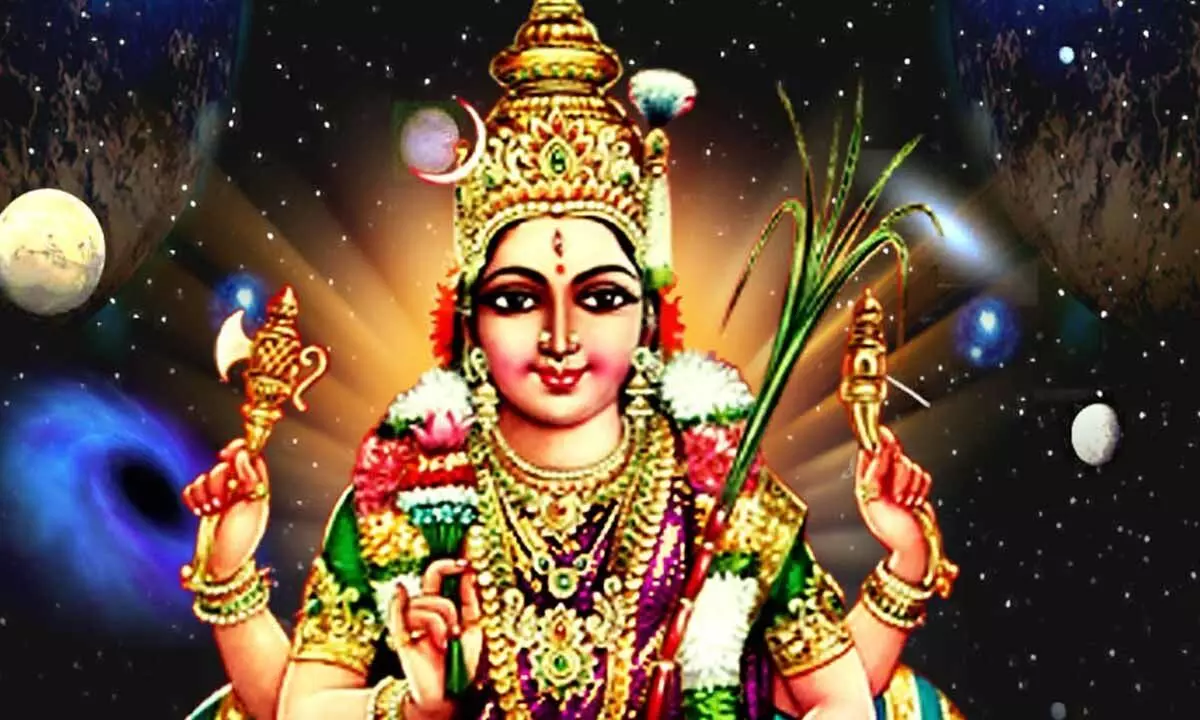Live
- Nizamabad MP Dharmapuri Arvind and Jagtial MLA Dr. Sanjay Kumar Meet CM Revanth Reddy
- Hyderabad CP CV Anand Issues Stern Warning to Bouncers
- MP Laxman Criticizes Police Conduct, Calls for Support for Victims' Families
- Fire Breaks Out in Kachiguda-Chennai Egmore Express, Passengers Evacuated Safely
- CM Revanth Reddy Condemns Attacks on Film Personalities' Homes, Calls for Strict Action
- Victory Venkatesh and Nandamuri Balakrishna to Set Screens on Fire with Unstoppable Season 4
- Over 71.81 crore Ayushman Bharat Health Account numbers generated: Centre
- In special gesture, Kuwait's Prime Minister sees-off PM Modi at airport after conclusion of historic visit
- Veer crowned PGTI Ranking champion, Shaurya wins emerging player honour
- Sr National Badminton: Unseeded Rounak Chauhan, Adarshini Shri reach singles semis
Just In

Another name says that Lalita has to be worshipped in a secret yagna. It was mistaken for a tantric yagna involving sacrifice of animals etc., but the meaning is different. It is jnana yajna, yajna of knowledge, which has to be performed in solitude and not in the midst of company, because we can understand reality through the mind only. Another name says that Lalita stays in the middle of Sudha-saagara. The literal meaning is an ocean of nectar. But the etymological meaning of saagara is a thing which has poison. As a result, the name means reality is something beyond the human reckoning of good and evil
One wonders how a person can have a thousand names, but people recite a thousand names of their favourite deity every day. How did the writers visualise so many names and on what logic? The truth is one; it has no change in it. The Upanishads call it a formless entity which is of the nature of pure consciousness, existing infinitely. If so, how did so many forms such as Vishnu, Shiva or Lalita get validated by the Upanishadic tradition?
That is because the sages saw human beings at different levels of understanding. A layman would not appreciate the statement ‘You are That (Supreme Reality)’. He has to be told what he can understand and move gradually from that level.
For instance, when we say energy (shakti), we presume a person with that energy, because energy belongs to someone. When Upanishads say that consciousness manifests as the universe because of the energy, then, the story-maker is ready to visualise a form, a female sitting on a male, or a female and male in one body, or a female always on the chest of a person and so on. One such visualisation is Lalita, a very popular deity in all parts of the country.
Why a thousand only and not one more or one less? True, we can have names, or even less. In the Indian tradition, a thousand means infinite. There can be no limits to the way we understand the highest reality. But the sages took the words describing the Supreme Brahman, such as, Brahman is beyond sensory cognition; it is infinite; it is in different forms; it is beyond time; it is manifesting as all beings in the past, present or future; and so on. All these are converted as names and given to Lalita, or Vishnu or Shiva, by merely changing the gender.
There is some sense of mystery or secrecy in some names. There is no fun if Vedanta is told in a prosaic manner. In the case of Lalita, we find many such names. One name says that she holds a sugarcane as a bow and the five elements as arrows. Sugarcane symbolises the mind because we experience all sensory pleasures in the mind only. The more we savor, the more desirable they appear, as in sugarcane. The five arrows are the five sense objects – a beautiful person is an arrow to the sight, a delicious dish is an arrow to the tongue, and so with other objects for the five senses we have. It can be otherwise too. Our five sense organs evolve from the five elements and hence they shoot out like arrows to the five sense objects in the world.
Another name says that Lalita has to be worshipped in a secret yagna. It was mistaken for a tantric yagna involving sacrifice of animals etc., but the meaning is different. It is jnana yajna, yajna of knowledge, which has to be performed in solitude and not in the midst of company, because we can understand reality through the mind only. Another name says that Lalita stays in the middle of Sudha-saagara. The literal meaning is an ocean of nectar. But the etymological meaning of saagara is a thing which has poison. As a result, the name means reality is something beyond the human reckoning of good and evil.
Why did the old sages use such symbolic expressions? There is a line in the Upanishads that gods take delight when they are addressed in an esoteric language. The lay reader is happy with the primary meaning and visualises a god or goddess of his choice, but a serious student investigates the figurative or symbolic meaning. We have to go to the etymology of the words to know the real meaning. It satisfies both the lay person and a serious student.
We may see that this was also an intelligent way to bring about social harmony by bringing various traditions under the umbrella of the Upanishads.
(The writer is a former DGP, Andhra Pradesh)

© 2024 Hyderabad Media House Limited/The Hans India. All rights reserved. Powered by hocalwire.com







